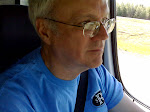




Similarities between Great Britain and the United States are enormous, built on the foundation of a common language. Touring in Scotland we have encountered numerous Europeans, and although we hear many different languages, Jane commented how increasingly the world dresses alike: denim jeans, T-shirts, running shoes, etc. You can now get a cold beer in a Scottish pub. In many pubs you can even get a Budweiser, although God only knows why you would want to when you can have a Macewans’ or a Caledonian or a John Smith or a Hebridean Gold or a Black Isle or a . . . .
But there are differences. Driving on the left side of the road is an obvious one. Europe is car enthusiast heaven. In two and a half weeks of touring I’ve seen six American cars. I don’t mean six American brands, I mean six cars made in America. But I’ve seen many marquees that are not on offer in the States: Skoda, Daihatsu, Citroen, Renault, Seat, Vauxhall, Peugeot. The most common vehicles are from Ford UK and Volkswagen: Ford Fiesta and Focus (versions not available in the States) and diesel powered VW Golf’s. The Ford Fiesta we are driving gets terrific mileage, handles well, and has been quite reliable. This suggests to me that what I have read over the past year about the U. S. Auto industry is correct. Their foreign units have already solved the gas mileage and emissions issues that would meet rigorous CAFÉ standards. They just neglected to bring them onshore in the U. S.
Every gas station we’ve stopped at has had diesel fuel on offer. And at least half of the cars we’ve seen have a TDI, CDi, SDi, or other diesel badge.
A major difference between the States and the UK is plumbing. In addition to my normal houseboy duties, on this trip I have become Jane’s shower hacker. Every place we have stayed has had a different shower arrangement, with different temperature and flow controls. For instance, in one B&B there was no response from the shower unit until I identified a switch outside the bathroom that controlled the power to it. The majority of the showers we’ve taken have been with on-demand heat units. Rather than use energy to keep a tank of water constantly warmed, even though not constantly needed, they have units that quickly heat the water when it’s needed. However, the controls on these units have great variety, even among units from the same vendor. Canny as the British have been in so many areas (after all they did initiate the industrial revolution), I have not yet heard a good explanation for why they still insist on having two separate faucets on bathroom sinks: one for hot, and one for cold water. Most places we’ve stayed have had scorching hot water. This means that whilst washing hands you lather them with soap and then sweep them in a quick arc back and forth between the scalding hot water and the cooling relief of cold. I’ve heard explanations that you are to put a stopper in the basin and fill it up with water to wash your hands. Not only does this take more time than seems warranted, but it can also leave you with that same “not quite completely rinsed” feeling that you get after taking a bath and not shower-rinsing afterwards.
But the real head-scratcher is the toilet. Britain could do with a good dose of Toto toilets. I’ve become Jane’s toilet hacker as well. To get these English (usually Armitage Shanks brand) toilets to flush takes a vigorous plunge and hold of the handle. Woe be unto he or she who is a woosey flusher (I suggested that this could be the name of a P. G. Wodehouse character, Dame Woosey Flusher)! I looked inside the tank to see why this is so. It appears that they use a complex siphoning mechanism to get the flow going. But the result seems to be many gallons of water used every flush, unlike Grace Church, where as I write, new, low water use toilets are being installed.
How a country this backwards in things related to WC water services can provide towel warmers in every bathroom is beyond comprehension. How utterly civilized to reach from the shower and fetch a warm towel with which to dry!
Instead of the typical Holiday Inn thin blankets and sheets we’ve slept under duvets. As we like to sleep with a window open, and since it gets cool during the night (down to 8 or 9 degrees centigrade) the duvets are welcome. There’s another difference: no screens. We have not seen one window screen in Scotland. They either don’t need them or choose to live with the consequences. We were concerned about midges that are bane of anyone who spends time outdoors in Scotland. We bought some Avon “Skin So Soft” to use as a repellent, but so far we’ve not had any need for it. Perhaps British insects are just as proper as their human neighbors.
There are other differences I’ve observed, but I’ll recount them some other time.


No comments:
Post a Comment